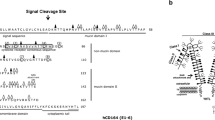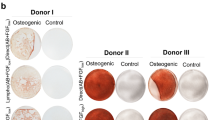Abstract
The cellular components of the hematopoietic stem cell niche have been gradually identified. However, the niche for malignant hematopoiesis remains to be elucidated. Here, using human leukemia cells, which could be transplanted to immunodeficient mice, we studied the in vivo homing, proliferation and survival sites by immunohistopathology, compared with the corresponding sites for cord blood CD34+ (CBCD34+) cells. The human leukemia cells initially localized on the surface of osteoblasts in the epiphysial region, and expanded to the inner vascular and diaphysial regions within 4 weeks. The percentage of CD34+ leukemia cells in the bone marrow was transiently increased up to 50%. In vivo 5-bromo-2′-deoxyuridine labeling revealed that the epiphysis was the most active site for leukemia cell proliferation. CBCD34+ cells showed the similar pattern of homing and proliferation to leukemia cells. After high-dose administration of cytosine-1-β-D-arabinofuranoside, residual leukemia cells were localized in the perivascular endothelium as well as in contact with the trabecular endosteum. These findings suggest that xenotransplantation into immunodeficient mice provides a useful model to study the leukemia niche.
This is a preview of subscription content, access via your institution
Access options
Subscribe to this journal
Receive 12 print issues and online access
$259.00 per year
only $21.58 per issue
Buy this article
- Purchase on Springer Link
- Instant access to full article PDF
Prices may be subject to local taxes which are calculated during checkout





Similar content being viewed by others
References
Whetton AD, Graham GJ . Homing and mobilization in the stem cell niche. Trends Cell Biol 1999; 9: 233–238.
Heissig B, Hattori K, Dias S, Friedrich M, Ferris B, Hackett NR et al. Recruitment of stem and progenitor cells from the bone marrow niche requires MMP-9 mediated release of kit-ligand. Cell 2002; 109: 625–637.
Yoshimoto M, Shinohara T, Heike T, Shiota M, Kanatsu-Shinohara M, Nakahata T . Direct visualization of transplanted hematopoietic cell reconstitution in intact mouse organs indicates the presence of a niche. Exp Hematol 2003; 31: 733–740.
Zhang J, Niu C, Ye L, Huang H, He X, Tong WG et al. Identification of the haematopoietic stem cell niche and control of the niche size. Nature 2003; 425: 836–841.
Zhu J, Emerson SG . A new bone to pick: osteoblasts and the haematopoietic stem-cell niche. Bioessays 2004; 26: 595–599.
Chute JP, Muramoto GG, Fung J, Oxford C . Soluble factors elaborated by human brain endothelial cells induce the concomitant expansion of purified human BM CD34+CD38− cells and SCID-repopulating cells. Blood 2005; 105: 576–583.
Balduino A, Hurtado SP, Frazao P, Takiya CM, Alves LM, Nasciutti LE et al. Bone marrow subendosteal microenvironment harbours functionally distinct haemosupportive stromal cell populations. Cell Tissue Res 2005; 319: 255–266.
Mendes SC, Robin C, Dzierzak E . Mesenchymal progenitor cells localize within hematopoietic sites throughout ontogeny. Development 2005; 132: 1127–1136.
Yin T, Li L . The stem cell niches in bone. J Clin Invest 2006; 116: 1195–1201.
Nilsson SK, Hulspas R, Weier HU, Quesenberry PJ . In situ detection of individual transplanted bone marrow cells using FISH on sections of paraffin-embedded whole murine femurs. J Histochem Cytochem 1996; 44: 1069–1074.
Nilsson SK, Johnston HM, Coverdale JA . Spatial localization of transplanted hemopoietic stem cells: inferences for the localization of stem cell niches. Blood 2001; 97: 2293–2299.
Haylock DN, Nilsson SK . Stem cell regulation by the hematopoietic stem cell niche. Cell Cycle 2005; 4: 1353–1355.
Taichman RS . Blood and bone: two tissues whose fates are intertwined to create the hematopoietic stem-cell niche. Blood 2005; 105: 2631–2639.
Nilsson SK, Johnston HM, Whitty GA, Williams B, Webb RJ, Denhardt DT et al. Osteopontin, a key component of the hematopoietic stem cell niche and regulator of primitive hematopoietic progenitor cells. Blood 2005; 106: 1232–1239.
Suda T, Arai F, Hirao A . Hematopoietic stem cells and their niche. Trends Immunol 2005; 26: 426–433.
Calvi LM, Adams GB, Weibrecht KW, Weber JM, Olson DP, Knight MC et al. Osteoblastic cells regulate the haematopoietic stem cell niche. Nature 2003; 425: 841–846.
Arai F, Hirao A, Ohmura M, Sato H, Matsuoka S, Takubo K et al. Tie2/angiopoietin-1 signaling regulates hematopoietic stem cell quiescence in the bone marrow niche. Cell 2004; 118: 149–161.
Taussig DC, Pearce DJ, Simpson C, Rohatiner AZ, Lister TA, Kelly G et al. Hematopoietic stem cells express multiple myeloid markers: implications for the origin and targeted therapy of acute myeloid leukemia. Blood 2005; 106: 4086–4092.
Bonnet D, Dick JE . Human acute myeloid leukemia is organized as a hierarchy that originates from a primitive hematopoietic cell. Nat Med 1997; 3: 730–737.
Hope KJ, Jin L, Dick JE . Acute myeloid leukemia originates from a hierarchy of leukemic stem cell classes that differ in self-renewal capacity. Nat Immunol 2004; 5: 738–743.
Jordan CT, Upchurch D, Szilvassy SJ, Guzman ML, Howard DS, Pettigrew AL et al. The interleukin-3 receptor alpha chain is a unique marker for human acute myelogenous leukemia stem cells. Leukemia 2000; 14: 1777–1784.
Bonnet D . Haematopoietic stem cells. J Pathol 2002; 197: 430–440.
Engelhardt M, Lubbert M, Guo Y . CD34+ or CD34−: which is the more primitive? Leukemia 2002; 16: 1603–1608.
Dias S, Hattori K, Heissig B, Zhu Z, Wu Y, Witte L et al. Inhibition of both paracrine and autocrine VEGF/VEGFR-2 signaling pathways is essential to induce long-term remission of xenotransplanted human leukemias. Proc Natl Acad Sci USA 2001; 98: 10857–10862.
Tavor S, Petit I, Porozov S, Avigdor A, Dar A, Leider-Trejo L et al. CXCR4 regulates migration and development of human acute myelogenous leukemia stem cells in transplanted NOD/SCID mice. Cancer Res 2004; 64: 2817–2824.
Ito M, Hiramatsu H, Kobayashi K, Suzue K, Kawahata M, Hioki K et al. NOD/SCID/γcnull mouse: an excellent recipient mouse model for engraftment of human cells. Blood 2002; 100: 3175–3182.
Xu J, Nagata K, Obata K, Ichihara S, Izawa H, Noda A et al. Nicorandil promotes myocardial capillary and arteriolar growth in the failing heart of Dahl salt-sensitive hypertensive rats. Hypertension 2005; 46: 719–724.
Hiramatsu H, Nishikomori R, Heike T, Ito M, Kobayashi K, Katamura K et al. Complete reconstitution of human lymphocytes from cord blood CD34+ cells using the NOD/SCID/γcnull mice model. Blood 2003; 102: 873–880.
Matsumura T, Kametani Y, Ando K, Hirano Y, Katano I, Ito R et al. Functional CD5+ B cells develop predominantly in the spleen of NOD/SCID/γcnull (NOG) mice transplanted either with human umbilical cord blood, bone marrow, or mobilized peripheral blood CD34+ cells. Exp Hematol 2003; 31: 789–797.
Yahata T, Ando K, Miyatake H, Uno T, Sato T, Ito M et al. Competitive repopulation assay of two gene-marked cord blood units in NOD/SCID/γcnull mice. Mol Ther 2004; 10: 882–891.
Zou YR, Kottmann AH, Kuroda M, Taniuchi I, Littman DR . Function of the chemokine receptor CXCR4 in haematopoiesis and in cerebellar development. Nature 1998; 393: 595–599.
Peled A, Petit I, Kollet O, Magid M, Ponomaryov T, Byk T et al. Dependence of human stem cell engraftment and repopulation of NOD/SCID mice on CXCR4. Science 1999; 283: 845–848.
Dar A, Goichberg P, Shinder V, Kalinkovich A, Kollet O, Netzer N et al. Chemokine receptor CXCR4-dependent internalization and resecretion of functional chemokine SDF-1 by bone marrow endothelial and stromal cells. Nat Immunol 2005; 6: 1038–1046.
Fragoso R, Pereira T, Wu Y, Zhu Z, Cabecadas J, Dias S . VEGFR-1 (FLT-1) activation modulates acute lymphoblastic leukemia localization and survival within the bone marrow, determining the onset of extramedullary disease. Blood 2006; 107: 1608–1616.
Kaplan RN, Riba RD, Zacharoulis S, Bramley AH, Vincent L, Costa C . VEGFR1-positive haematopoietic bone marrow progenitors initiate the pre-metastatic niche. Nature 2005; 438: 820–827.
Baumheter S, Singer MS, Henzel W, Hemmerich S, Renz M, Rosen SD et al. Binding of L-selectin to the vascular sialomucin CD34. Science 1993; 262: 436–438.
Baumhueter S, Dybdal N, Kyle C, Lasky LA . Global vascular expression of murine CD34, a sialomucin-like endothelial ligand for L-selectin. Blood 1994; 84: 2554–2565.
Puri KD, Finger EB, Gaudernack G, Springer TA . Sialomucin CD34 is the major L-selectin ligand in human tonsil high endothelial venules. J Cell Biol 1995; 131: 261–270.
Acknowledgements
This study was supported by Grants-in-Aid from the Ministry of Education, Culture, Sports, Science and Technology, and the Pharmaceuticals and Medical Devices Agency. We thank Ms Satomi Yamaji and Yuka Nomura for technical assistance, and Ms Manami Kira and Mari Otsuka for secretarial assistance.
Author information
Authors and Affiliations
Corresponding author
Additional information
Supplementary Information accompanies the paper on the Leukemia website (http://www.nature.com/leu)
Rights and permissions
About this article
Cite this article
Ninomiya, M., Abe, A., Katsumi, A. et al. Homing, proliferation and survival sites of human leukemia cells in vivo in immunodeficient mice. Leukemia 21, 136–142 (2007). https://doi.org/10.1038/sj.leu.2404432
Received:
Revised:
Accepted:
Published:
Issue Date:
DOI: https://doi.org/10.1038/sj.leu.2404432
Keywords
This article is cited by
-
Cell surface expression of GRP78 and CXCR4 is associated with childhood high-risk acute lymphoblastic leukemia at diagnostics
Scientific Reports (2022)
-
Endothelial E-selectin inhibition improves acute myeloid leukaemia therapy by disrupting vascular niche-mediated chemoresistance
Nature Communications (2020)
-
Development and analysis of patient-derived xenograft mouse models in intravascular large B-cell lymphoma
Leukemia (2016)
-
Survival regulation of leukemia stem cells
Cellular and Molecular Life Sciences (2016)
-
Leukemia cell mobilization with G-CSF plus plerixafor during busulfan–fludarabine conditioning for allogeneic stem cell transplantation
Bone Marrow Transplantation (2015)



